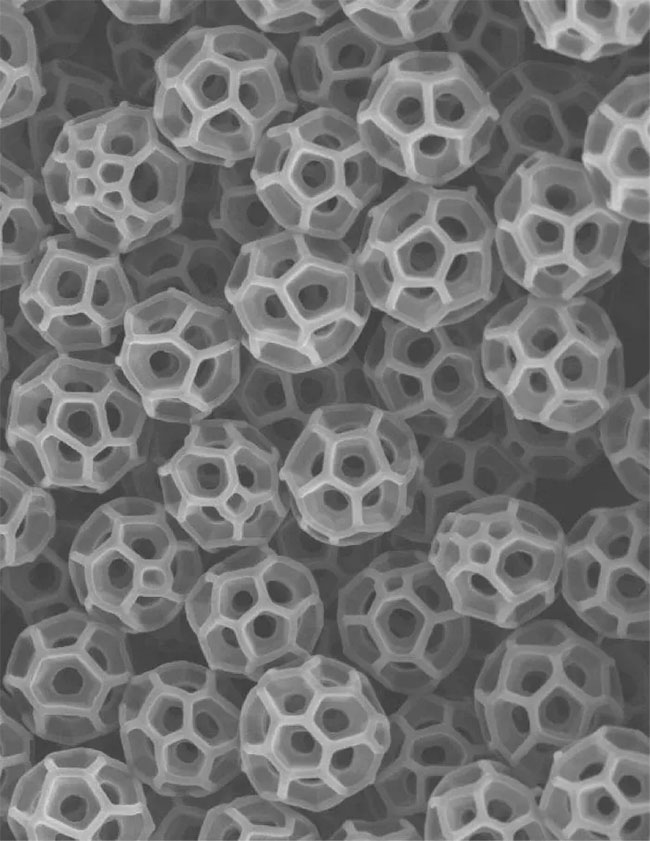Scientists create stealth device inspired by insects
The leafhopper - a common leaf-eating insect that secretes small brochosome particles, could be the inspiration for scientists to create stealth technology.
Decoding brochosomes

Brochosomes are produced by leafhoppers.
These unique, small particles have an unusual shape that resembles a soccer ball with hollow holes. Their exact effect on leafhoppers has been a mystery since the 1950s.
By 2017, Tak-Sing Wong - professor of mechanical engineering and biomedical engineering at Pennsylvania State University (USA) led the first research team to create a basic, synthetic version of brochosomes to better understand their function.
Lin Wang, a postdoctoral scholar in mechanical engineering and lead author of the above study, said that this discovery could be very useful for technological innovation. With a new strategy to regulate the reflection of light on surfaces, we can hide the heat signature of humans or machines. One day humans may develop thermal invisibility cloaks based on the tricks used by leafhoppers.
'Our work shows how understanding nature can help us develop modern technologies,' said Mr. Lin Wang, going on to explain that, although scientists already know about brochosomes for three-quarters of a century, but making them in the laboratory remains a challenge due to the complexity of the particle's shape.
According to Mr. Lin Wang, it is unclear why leafhoppers create seeds with such a complex structure. The researchers created these brochosomes using high-tech 3D printing in the laboratory.
They found that these particles can reduce light reflection by up to 94% . This is a big discovery, because for the first time we see nature controlling light in its own way.
Many theories have been put forward as to why leafhoppers don brochosomal armor , from keeping them out of pollutants and water to creating an invisibility cloak. However, knowledge of the geometry of the brochosome suggests that its main purpose is most likely to avoid predators, according to Professor Tak-Sing Wong.
Besides, the size of the pores on the brochosome giving it a hollow, soccer-like shape is very important. In particular, this size is consistent for all species of leafhoppers. Brochosomes are about 600 nanometers in diameter, about half the size of a bacterium, and brochosome pores are about 200 nanometers in diameter.
'That led us to ask the question, why are these similar sizes? What is the secret to having brochosomes that are about 600 nanometers in size with pores about 200 nanometers? Does that serve any purpose?' , Mr. Wong said.

Leafhoppers produce brochosomes to cover their body surface.
Great technological prospects
The researchers found that the brochosome's unique design serves a dual purpose. It absorbs ultraviolet (UV) rays, reducing the visibility of predators with UV vision (such as birds and reptiles), while also scattering light , creating an anti-reflective shield, preventing potential threat. The size of the holes is perfect for absorbing light at ultraviolet frequencies.
This has the potential to yield many applications for humans using synthetic brochosomes. In particular, it helps the system to harvest solar energy more effectively, making advanced sunscreen to help protect the skin better against the harmful effects of sunlight. Researchers are also looking at developing invisibility cloaks or camouflage devices inspired directly by leafhoppers.
To test the above, the team first faced the huge challenge of creating synthetic brochosomes . In the 2017 study, scientists simulated some of the characteristics of brochosomes, especially pores and their distribution, using synthetic materials. However, they were only able to create something that looked like brochosomes and not an exact copy.
'This is the first time we have been able to create the exact shape of the natural brochosome' - Professor Wong said, explaining that the researchers were able to create proportional synthetic copies of the brochosome structure using advanced 3D printing technology.
The researchers created a scaled-down version equivalent to one-fifth the diameter of a human hair, while accurately reproducing the shape and morphology, as well as the number and location of the pores.
Pseudobrochosomes are small but large enough to be characterized optically. The team now wants to improve the process for producing synthetic brochosomes in the hopes of getting closer to their actual size.
Professor Wang noted that their brochosome work demonstrates the value of a biomimicry research approach, where scientists look to nature for inspiration. He believes that nature is a good teacher for scientists to develop new advanced materials.
"We have only focused on one insect, but there are many more amazing insects waiting to be studied by materials scientists. They can help us solve the problem," said researcher Lin Wang. various technical problems. They are not only insects but also inspiration ".
- Insects could inspire stealth technology
- Next-generation flying robot is inspired by small insects
- Stealth camera detection device
- Ways to create a stealth letter from the most basic items
- Successfully fabricated 'thermal cloak'
- What is stealth technology? How does it work?
- America shows off a stealthy flagship bearing the nickname 'ghost'
- The invisible port is about to come true
- Camera based on insect eyes
- China's 'cheap' stealth technology can outmaneuver military radar systems
- Will soon have stealth mats
- Successfully making stealth material can make the person behind it disappear!
 The US company is about to build a supersonic passenger plane of 6,000km / h
The US company is about to build a supersonic passenger plane of 6,000km / h Japan develops avatar robot as in fiction film
Japan develops avatar robot as in fiction film Australia tested the world's first mango picking robot
Australia tested the world's first mango picking robot America develops technology to separate water from animal waste
America develops technology to separate water from animal waste